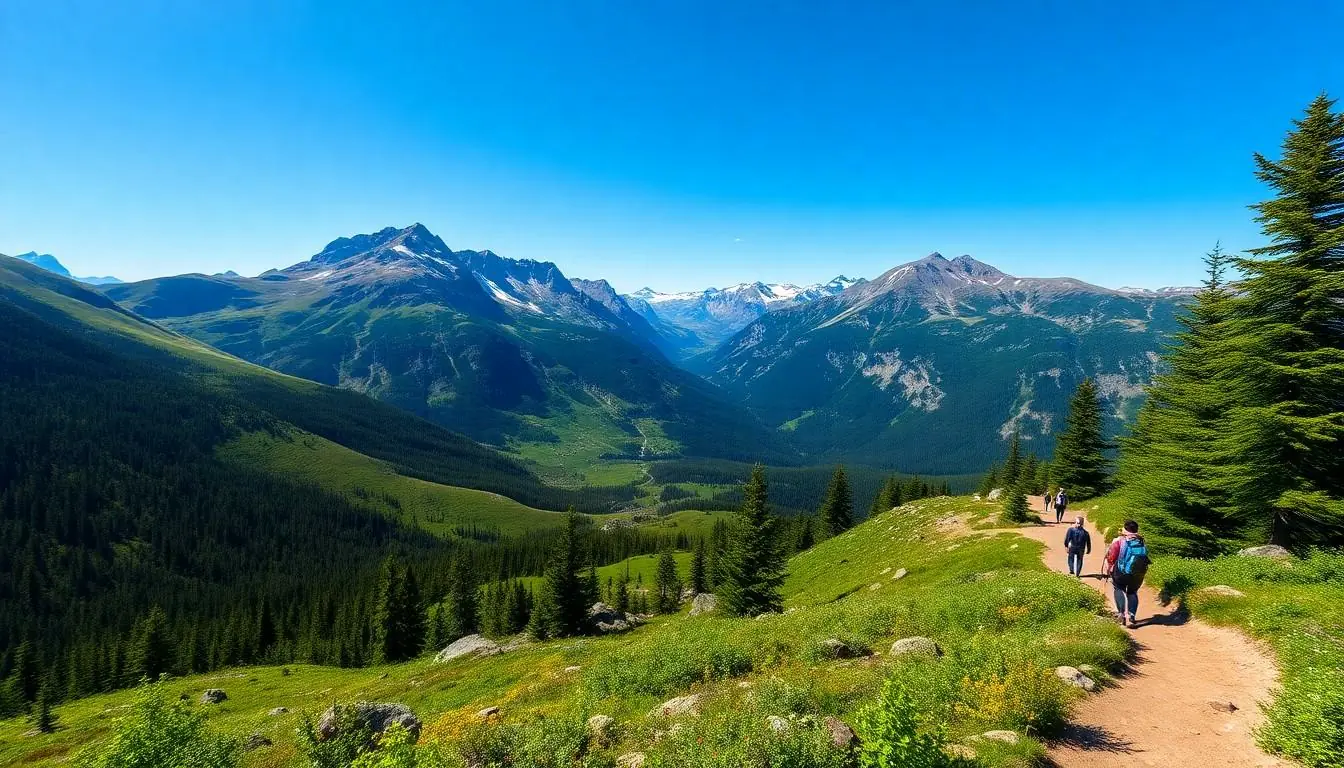Table of Contents
TogglePlanning a trip to Canada? Timing can make all the difference between a spectacular adventure and a soggy experience. With its breathtaking landscapes and vibrant cities, Canada’s charm shifts with the seasons. From snow-capped mountains perfect for skiing to sun-soaked beaches ideal for lounging, there’s a sweet spot for every traveler.
Understanding Seasonal Changes
Canada’s beauty unfolds uniquely throughout the year. Each season presents distinct experiences for travelers, shaping activities and attractions available across provinces.
Winter in Canada
Winter transforms Canada into a snowy wonderland. Ski resorts in British Columbia and Alberta attract enthusiasts with trails catering to all skill levels. Quebec offers a vibrant après-ski culture, while cities like Montreal host winter festivals showcasing ice sculptures and local cuisine. The northern regions, such as Yukon, provide opportunities for viewing the Northern Lights, making this a prime time for adventure seekers.
Spring in Canada
Spring breathes life into Canada’s landscapes. Cherry blossoms bloom in Vancouver, while tulip festivals brighten Ottawa, drawing visitors eager for vibrant colors. Wildlife becomes more active during this season, with opportunities for hiking and birdwatching in national parks like Banff and Jasper. This transitional period also marks the start of many outdoor events, including gardening shows and food festivals, appealing to locals and tourists alike.
Summer in Canada
Summer evokes outdoor exploration and adventure across Canada. National parks buzz with life, inviting hiking, camping, and kayaking among picturesque lakes and mountains. Cities like Toronto and Vancouver come alive with festivals celebrating arts, culture, and music. Coastal regions, including the Maritime Provinces, offer stunning beaches perfect for relaxation or water sports. This season balances warmth and excitement, attracting families and outdoor enthusiasts.
Fall in Canada
Fall showcases Canada’s breathtaking foliage. Leaves turn vibrant hues, particularly in regions like New England and Ontario, attracting photographers and nature lovers. Harvest festivals abound, featuring local produce and artisanal goods, while wine regions such as Niagara showcase their vintages through tours and tastings. The cooler temperatures provide pleasant conditions for explorations, making this an ideal season for road trips and scenic views.
Factors to Consider

Several factors play a crucial role in determining the best time to travel to Canada. Understanding these aspects helps travelers plan an enjoyable visit.
Weather Conditions
Weather conditions greatly impact the travel experience. Winter temperatures can drop below freezing, ideal for skiing and snow sports in regions like Whistler and Banff. Conversely, summer boasts milder temperatures averaging 70°F to 80°F, making it perfect for outdoor adventures like hiking in the Rockies. Spring displays vibrant blooms and an increase in wildlife activity, while fall offers crisp air and stunning foliage, attracting those eager for scenic photography.
Peak Tourist Seasons
Peak tourist seasons significantly affect travel plans. Summer months, especially July and August, witness the highest visitor numbers, leading to crowded attractions and increased accommodation rates. Conversely, shoulder seasons in late spring and early fall provide a balance with fewer tourists while retaining pleasant weather. Traveling during these times allows for a more relaxed experience and often lower prices, making it an attractive option for budget-conscious travelers.
Local Events and Festivals
Local events and festivals enhance the appeal of visiting Canada. Major events like the Toronto International Film Festival in September draw international attention. Celebrations such as Canada Day on July 1st showcase national pride with parades and fireworks. Winter festivals like Quebec City’s Winter Carnival offer unique cultural experiences during the colder months. Aligning travel dates with these events can enrich the journey, providing insights into local culture and traditions.
Best Time for Different Activities
Travelers find that Canada offers a range of activities depending on the season. Each season presents unique opportunities for exploration and enjoyment.
Winter Sports and Activities
Winter defines Canada’s landscapes, making it the best time for skiing and snowboarding. Resorts in Whistler and Banff attract snow enthusiasts with miles of pristine slopes. Ice skating on frozen lakes and snowshoeing through winter trails become popular pastimes. Festivals such as the Quebec Winter Carnival highlight the joy of the season and enrich the travel experience. Travelers can fully immerse themselves in winter fun from December to March.
Summer Outdoor Adventures
Summer transforms Canada into a playground for outdoor adventures. Hiking in the Rocky Mountains offers breathtaking views and challenging trails. Lakes in Banff and Jasper invite swimming and kayaking in warmer temperatures. Cultural festivals like the Calgary Stampede showcase local traditions and vibrant celebrations. From June to August, visitors enjoy pleasant weather perfect for camping and road trips. Various national parks become prime destinations for wildlife watching during these months.
Cultural Experiences in the Fall
Fall captivates visitors with stunning foliage and harvest celebrations. Exploring wine regions in Niagara-on-the-Lake offers opportunities for wine tasting amid autumn colors. Festivals such as the Toronto International Film Festival draw in cinema lovers with world-renowned films. The crisp air also enhances hiking experiences in picturesque spots like Algonquin Park. Travelers can expect a vibrant cultural scene from September to October, making this a favorite time for locals and tourists alike.
Tips for Planning Your Trip
Planning a trip to Canada requires careful consideration of various factors to enhance the travel experience. Optimize your itinerary by focusing on seasonal activities, local events, and budget-friendly options.
Finding the Right Deals
Look for seasonal promotions on flights and accommodations, especially during shoulder seasons in late spring and early fall. Several websites offer price alerts and comparisons, ensuring travelers access the best rates. Consider booking packages that combine flights with activities, which can provide additional savings. Airlines frequently run sales during off-peak times, making it possible to secure lower prices. Staying flexible with travel dates also opens more opportunities for discounted fares.
Packing Essentials for Each Season
Pack clothing suited for each season’s weather conditions. In winter, prioritize thermal layers, waterproof outerwear, and sturdy boots for snow activities. Spring and fall call for versatile jackets and comfortable footwear for exploring diverse landscapes. Summer necessitates lightweight clothing, sunscreen, and swimwear for beach outings and hiking adventures. Beyond clothing, remember to bring essentials like insect repellent for summer trips and a good camera to capture Canada’s breathtaking scenery throughout the year.
Timing is essential when planning a trip to Canada. Each season offers unique experiences that cater to various interests and preferences. Whether it’s winter sports or summer festivals there’s something for every traveler throughout the year.
By considering weather conditions peak tourist seasons and local events travelers can optimize their visit. The shoulder seasons provide a perfect balance of pleasant weather and fewer crowds making them an attractive option for many.
Ultimately understanding the best times to travel allows visitors to fully immerse themselves in Canada’s diverse landscapes and vibrant culture ensuring an unforgettable experience.





